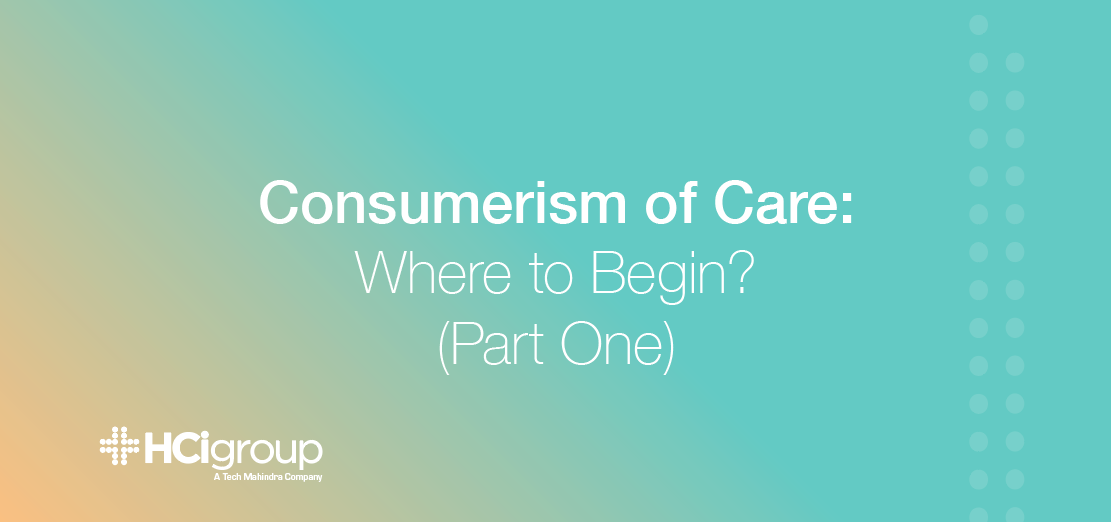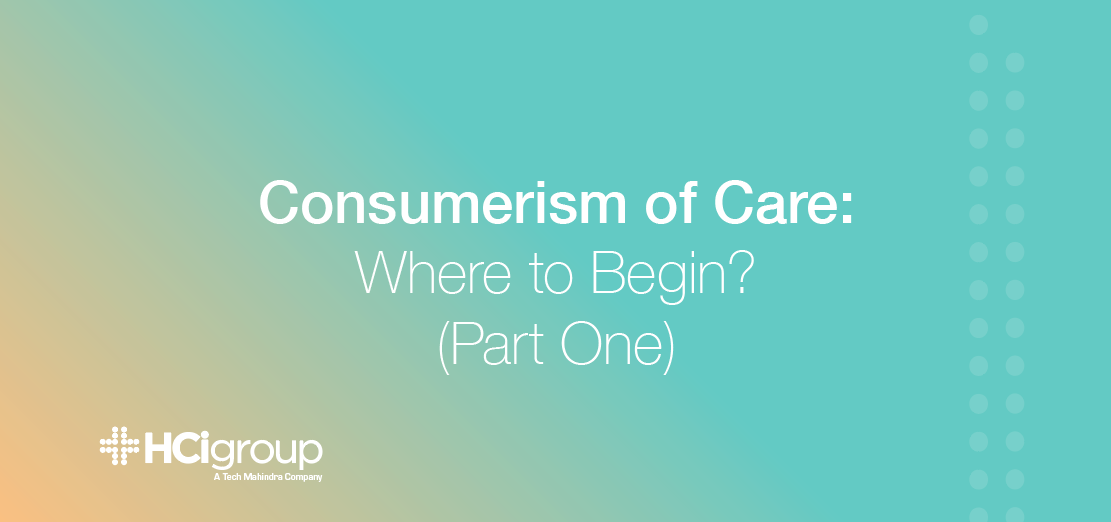Consumerism of Care: Where to Begin? (Part One)

 Imagine logging onto an eCommerce site searching for a new computer and without real choice, comparison or input; the eCommerce organization ships a computer of their choice - not telling you the quality, utilization, delivery date, product reviews, tracking position, price, or most importantly, not understanding you as the consumer. We can apply consumer tactics we have learned from the success of mega eCommerce organizations into external and internal Healthcare Provider entities.
Imagine logging onto an eCommerce site searching for a new computer and without real choice, comparison or input; the eCommerce organization ships a computer of their choice - not telling you the quality, utilization, delivery date, product reviews, tracking position, price, or most importantly, not understanding you as the consumer. We can apply consumer tactics we have learned from the success of mega eCommerce organizations into external and internal Healthcare Provider entities.
This candid interview with The HCI Group’s Global Advisory Service’s Head, Tom Vasko, will uncover the firm’s enterprise view, global perspective, and approach on getting your provider organization to the front of the leader board on its journey of truly transforming next generational healthcare.
Tom, can we start with understanding what consumerism of healthcare really means?
We just recently completed a strategic engagement in Australia with a newly minted HIMSS Stage 7 organization regarding their continuance of their digitalization journey across their hospitals and enterprise which spanned across the entire continent. The engagement started with an internal and competitor stakeholder engagement, focused around qualitative and quantitative market analysis, digital vision, strategy and sustainment for 10 of the leading health organizations in Australia. Consumerism in care both from an external and internal perspective was at the top of their list of importance. How can we retain and attract consumers and improve their care? It was equally important to provide the same outcome for organizational talent. How do we attract and retain the top talent in the industry from all clinical and business operating arms?
We believe consumerism is exactly that, two-fold, internally those involved in every aspect of service for the organization. Secondly, at equal of importance, the consumer enablement and experience. During this engagement, we analysed cross industries of hospitality, retail and banking. We wanted to understand the holistic cultural underpinnings of the Australian population to help establish consumer initiatives that drove high return, satisfaction and outcomes. Simply, relying on healthcare provider consumer and stakeholder feedback would be short changing the opportunity to disrupt healthcare through innovation. The ideas around consumerism and security we obtained through this analysis and are now on our client’s road map for implementation this coming year were impactful and the differentiator. Focus on the internal and external stakeholders; emphasis on individual enablement/empowerment, quality, safety, ease of navigation, security, informative comparison and breaking the pedestrian barriers of care delivery.
What do you believe are the main areas of and/or common deficits in getting healthcare organizations to the level of consumerism?
I think truly it begins with collapsing the traditional mindset of healthcare delivery. The pressure of reducing operating costs, improving operational efficiency, value-based care shift along with regulatory and reimbursement guidelines; it’s not conductive to our traditional mindset and care delivery models. I can remember as a bedside clinician performing care, based on evidenced based nursing without question - never really empowering the patient to assist, contribute or drive their care. I was hindering and going against the grain of the nursing model, which was ingrained in me during my educational journey at Eastern Michigan University school of Nursing. Patient education is the core of nursing; however, we should be looking to take it a step further, into patient care collaboration. Developing an empowering rapport develops cohesion and inclusion, ultimately educating both the clinician and patient on all aspects of their health, past, present and future.
Additionally, healthcare provider organizations should understand how consumerism of their care and operational models result in clear return of investment (ROI). It can range from safety, quality, outcomes, financial reduction, increased revenue and so on. This occurs from both external and internal investment. Treating staff and independent practices as consumers improves referral percentages, retention, standardized care - decreasing operating costs and increasing revenue capture. Creating a journey, fluid patient experience, and understanding your patient population characteristics has a direct relation. In simplistic terms, healthcare organizations should accept patients have choices on where and how to receive healthcare, identify their organizations as service industries and aim to please their consumers based on their benefit realizations and global benchmarks.

Can you talk to differences you see with your international clients and their delivery models specific to consumerism in healthcare?
This is a great question. Over this year alone we have engaged clients throughout the Middle East, United States, Canada, United Kingdom, China, Australia, Nordics and New Zealand, to name a few. These countries have varying care delivery models, funding, regulatory markers, reimbursement, population health, culture, disease states, and environmental influencers. It is deeply complex in differentiation from what we’ve seen in the United States. I have yet to see a model nation for the United States to fully adopt or mimic per say. It’s been a long debate in our nation on whether we should be fee for service, value based, universal etc., however, it’s not that simple, and why we are still searching for the “golden egg” which doesn’t exist. It truly will take far greater foreign and domestic influence to get there. Internationally consumerizing healthcare through organizational shift and technology enablement is top priority for the majority of our clients and a stake on their strategic road map for this coming year.
The cause, or driver of the interest, is where we are seeing the greatest variance. For example, in Australia, public health organizations are luring patients away from private entities based on consumer tactics. A “one stop shop” mentality and the ease of navigation from entry, to discharge, to prevention, is attracting patients to become loyal patrons of public care. The private entities are focused heavily on consumerism in tandem through digitalization and interoperability of disparate systems through technology solutions such as Miverva (MphRx). Minerva pulls patient data together in a single view to improve efficiency, outcomes, population management, care coordination, consumer engagement, remote monitoring, legacy and image exchange. It is less costly than a full EHR replacement and has been successful with many of our global clients. Here in the U.S. we are seeing a steady uptick in our M&A client portfolio, acquiring of independent practices, regional and rural health facilities battling for existence. It is important for our regional, rural and independents to focus on consumerism, shedding costs through consumerism and technology enablement rather than staff reduction. These two really complement each other well. A regional facility should focus on services or types of specialties of care. Truly manage their populations, through consumer models similar in hospitality and retail by taking a small business approach.
About Tom Vasko, BSN
Tom is a graduate of Eastern Michigan University - School of Nursing. He is a longtime Organizational Transformation and Talent expert beginning his career in the U.S. Military in all aspects of change management through the complexities of People, Process, Infrastructure and Technology enablement. An alumnus of Deloitte Consulting and currently The HCI Group’s Global Head for Advisory Services. He has touched healthcare organizations throughout the United States, Europe, Canada, Asia, Middle East and Australia grasping a full suite of care delivery, technology and organizational models. Tom is known as a tactical innovator in healthcare IT, organizational strategy, and a published population health outcomes researcher.

